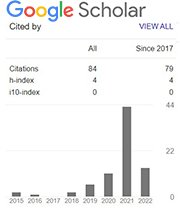Studi Awal Adaptasi Alat Ukur Leisure Satisfaction di Indonesia
Abstract
Keywords
Full Text:
PDF (Bahasa Indonesia)References
Beard, J. G., & Ragheb, M. G. (1980). Measuring leisure satisfaction. Journal of Leisure Research, 12(1), 20–33. https://doi.org/10.1080/00222216.1980.11969416
Beaton, D., Bombardier, C., Guillemin, F., & Ferraz, M. B. (2000). Guidelines for the Process of Cross-Cultural Adaptation of Self-Report Measures. SPINE, 25(24), 3186–3191. https://doi.org/10.1080/000163599428823
Chen, L. H., & Chancellor, H. C. (2019). Examining attitudes toward bicycle-share program use: A dual-process theory approach. Transportation Research Part F: Traffic Psychology and Behaviour, 62, 769–781. https://doi.org/10.1016/j.trf.2019.03.007
He, D., Xi, B., Xue, J., Huai, P., Zhang, M., & Li, J. (2014). Association between leisure time physical activity and metabolic syndrome: A meta-analysis of prospective cohort studies. Endocrine, 46(2), 231–240. https://doi.org/10.1007/s12020-013-0110-0
Hu, L. T., & Bentler, P. M. (1999). Cutoff criteria for fit indexes in covariance structure analysis: Conventional criteria versus new alternatives. Structural Equation Modeling, 6(1), 1–55. https://doi.org/10.1080/10705519909540118
Ito, E., Walker, G. J., Liu, H., & Mitas, O. (2017). A Cross-Cultural/National Study of Canadian, Chinese, and Japanese University Students’ Leisure Satisfaction and Subjective Well-Being. Leisure Sciences, 39(2), 186–204. https://doi.org/10.1080/01490400.2016.1165637
Johanson, G. A., & Brooks, G. P. (2010). Initial scale development: Sample size for pilot studies. Educational and Psychological Measurement, 70(3), 394–400. https://doi.org/10.1177/0013164409355692
Kaplan, R. M., & Sacuzzo, D. (2008). Psychological Testing (Seventh Ed). Wadsworth Cengage Learning.
Mannell, C. (2007). Leisure, Health and Well-Being. World Leisure, 1(3), 114–128.
Muzindutsi, P.-F., & Masango, Z. (2015). Determinants of Leisure Satisfaction Among Undergraduate Students at a South African University. International Journal of Business and Management Studies, 7(2), 1–15.
Ngai, V. T. (2005). Leisure satisfaction and quality of life in Macao, China. Leisure Studies, 24(2), 195–207. https://doi.org/10.1080/02614360412331313502
Stacey, T. L., Froude, E. H., Trollor, J., & Foley, K. R. (2019). Leisure participation and satisfaction in autistic adults and neurotypical adults. Autism, 23(4), 993–1004. https://doi.org/10.1177/1362361318791275
Trottier, A. N., Brown, G. T., Hobson, S. J. G., & Miller, W. (2002). Reliability and validity of the Leisure Satisfaction Scale (LSS - Short form) and the Adolescent Leisure Interest Profile (ALIP). Occupational Therapy International, 9(2), 131–144. https://doi.org/10.1002/oti.161
Walker, G. J., Deng, J., & Spiers, A. (2009). Leisure, acculturative stress, and immigrants’ subjective well-being.
Wiese, C. W., Kuykendall, L., & Tay, L. (2018). Get active? A meta-analysis of leisure-time physical activity and subjective well-being. Journal of Positive Psychology, 13(1), 57–66. https://doi.org/10.1080/17439760.2017.1374436
DOI: https://doi.org/10.21107/personifikasi.v12i2.11690
Refbacks
- There are currently no refbacks.
Copyright (c) 2021 Mustika Ema Linda Siregar, Novika Grasiaswaty

This work is licensed under a Creative Commons Attribution 4.0 International License.


Personifikasi by Universitas Trunojoyo Madura is licensed under a Creative Commons Attribution 4.0 International License.










